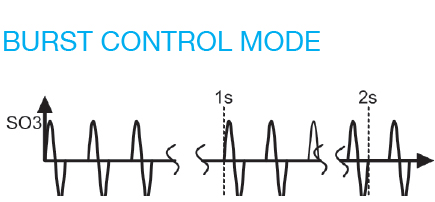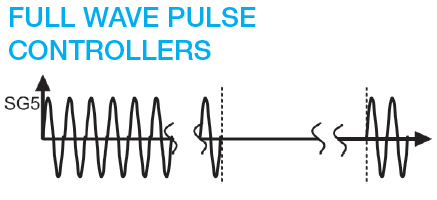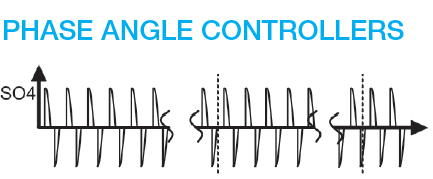Blog - EXPERTISE & INNOVATIONS - Solid State Relays - ANALOGUE CONTROL RELAYS
celduc® relais offers a wide range of controllers with various control modes and input types.
Types of input control:
3 control modes are available:
You are now wondering how to choose the best suitable mode for your application ?
In this blog article we are making a comparison of these 3 control modes (setting to 50%). It will help you better understand their working principles, advantages and typical applications.

In a given cycle time (in this case, 1 or 2 seconds), the variation of the load power is achieved by eliminating whole alternations. Eliminations are distributed in accordance with a complex rule. Thus, in this example, the load is only powered to 50% because of the elimination of one alternation out of two.
This type of control makes it possible for the power to be finely modulated in accordance with the analogue control, while limiting disturbances.
For controlling resistive loads at low thermal inertia, such as short wave infrared emitters
(infrared heater bulbs)
This control mode makes it possible for the power to be finely modulated in accordance with the analogue control, while limiting disturbances.
This control mode consists of switching the streams of full sine waves equally distributed along a fixed modulation period (TM) in accordance with the analogue input signal. The μP constantly computes the number of full sine waves to be switched along the TM period.

In a given cycle time (variable depending on the models), the variation of the load power is achieved by eliminating whole alternations.
The elimination is performed linearly in accordance with the Ton/Tcycle duty cycle requested by the control input.
Thus, in this example, the load is only powered for 50% of the cycle time Ton/Tcycle=0.5).
This type of control has the advantage of not generating interference since trigger takes place at around 0 voltage.
This control mode is suitable for high inertia loads (industrial furnaces, etc.).
Celduc’s SG5 controllers have an analogue input isolated from the mains to proportionally vary the operating duty cycle of a load (t/T) in relation to the input voltage. This control mode consists of switching the streams of full sine waves equally distributed along a fixed modulation period (TM) in accordance with the analogue input signal. Models equipped with an LED and protection via RC and VDR network.

In terms of the principle of the light dimmer, this control mode makes it possible to finely vary the load power by removing a part of the supply voltage sinusoid in accordance with the control input.
The proportional response between the control input and the power output depends on the controller model and can be linear in angle, U² or in Urms.
Thus, in this example, the load is only powered to 50% because of the elimination of half of the supply voltage’s half cycles.
This control mode makes it possible to finely adjust the load power, for example, when the accuracy of the temperature regulation is prioritised over the electromagnetic disturbances generated by this type of solution (a filter is recommended).
Mainly for loads that rapidly react when faced with voltage variations (lamps, motors, etc.).
Also for DC loads behind a rectifier bridge (heater wires, Peltier effect modules, etc.).
Celduc is offering single phase and three-phase analogue control relays with phase angle control mode.
-Single phase, phase angle controllers
For controlling resistive loads :
-Resistive loads for temperature control (infrared lamps, furnaces, heating elements, etc.)
-Resistive loads for lighting control (filament and halogen lamps, stage lighting, etc.)
For controlling any type of load (except capacitive loads), 3 or 4-wire (neutral), delta or star assembly:
• Motor loads for speed control (depending on the type of motor and machine).